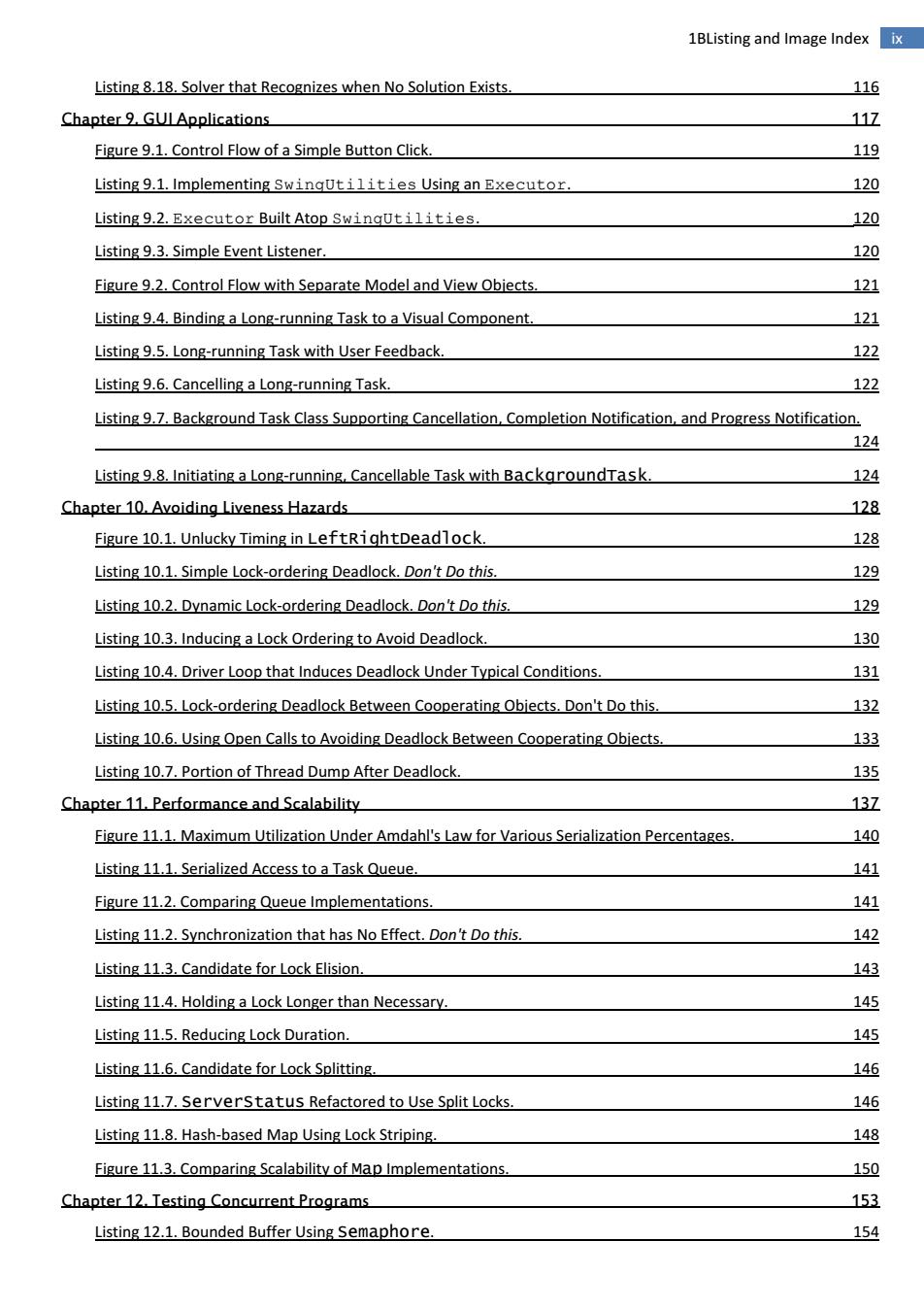正在加载图片...

1BListing and Image Index Listing 8.18.Solver that Recognizes when No Solution Exists. 116 Chapter 9 GUl Applications 11Z Figure 9.1.Control Flow of a Simple Button Click. 119 Listing 9.1.Implementing SwingUtilities Using an Executor. 120 Listing 9.2.Executor Built Atop SwingUtilities. 120 Listing 9.3.Simple Event Listener. 120 Figure 9.2.Control Flow with Separate Model and View Objects. 121 Listing 9.4.Binding a Long-running Task to a Visual Component. 121 Listing 9.5.Long-running Task with User Feedback. 122 Listing 9.6.Cancelling a Long-running Task. 122 Listing 9.7.Background Task Class Supporting Cancellation,Completion Notification,and Progress Notification. 124 Listing 9.8.Initiating a Long-running,Cancellable Task with BackgroundTask. 124 Chapter 10.Avoiding Liveness Hazards 128 Figure 10.1.Unlucky Timing in LeftRightDeadlock. 128 Listing 10.1.Simple Lock-ordering Deadlock.Don't Do this. 129 Listing 10.2.Dynamic Lock-ordering Deadlock.Don't Do this. 129 Listing 10.3.Inducing a Lock Ordering to Avoid Deadlock. 130 Listing 10.4.Driver Loop that Induces Deadlock Under Typical Conditions. 131 Listing 10.5.Lock-ordering Deadlock Between Cooperating Objects.Don't Do this. 132 Listing 10.6.Using Open Calls to Avoiding Deadlock Between Cooperating Objects. 133 Listing 10.7.Portion of Thread Dump After Deadlock. 135 Chapter 11.Performance and Scalability 13Z Figure 11.1.Maximum Utilization Under Amdahl's Law for Various Serialization Percentages. 140 Listing 11.1.Serialized Access to a Task Queue. 141 Figure 11.2.Comparing Queue Implementations. 141 Listing 11.2.Synchronization that has No Effect.Don't Do this. 142 Listing 11.3.Candidate for Lock Elision. 143 Listing 11.4.Holding a Lock Longer than Necessary. 145 Listing 11.5.Reducing Lock Duration. 145 Listing 11.6.Candidate for Lock Splitting. 146 Listing 11.7.Serverstatus Refactored to Use Split Locks. 145 Listing 11.8.Hash-based Map Using Lock Striping. 148 Figure 11.3.Comparing Scalability of Map Implementations. 150 Chapter 12.Testing Concurrent Programs 153 Listing 12.1.Bounded Buffer Using Semaphore. 1541BListing and Image Index ix Listing 8.18. Solver that Recognizes when No Solution Exists. 116 Chapter 9. GUI Applications 117 Figure 9.1. Control Flow of a Simple Button Click. 119 Listing 9.1. Implementing SwingUtilities Using an Executor. 120 Listing 9.2. Executor Built Atop SwingUtilities. 120 Listing 9.3. Simple Event Listener. 120 Figure 9.2. Control Flow with Separate Model and View Objects. 121 Listing 9.4. Binding a LongͲrunning Task to a Visual Component. 121 Listing 9.5. LongͲrunning Task with User Feedback. 122 Listing 9.6. Cancelling a LongͲrunning Task. 122 Listing 9.7. Background Task Class Supporting Cancellation, Completion Notification, and Progress Notification. 124 Listing 9.8. Initiating a LongͲrunning, Cancellable Task with BackgroundTask. 124 Chapter 10. Avoiding Liveness Hazards 128 Figure 10.1. Unlucky Timing in LeftRightDeadlock. 128 Listing 10.1. Simple LockͲordering Deadlock. Don't Do this. 129 Listing 10.2. Dynamic LockͲordering Deadlock. Don't Do this. 129 Listing 10.3. Inducing a Lock Ordering to Avoid Deadlock. 130 Listing 10.4. Driver Loop that Induces Deadlock Under Typical Conditions. 131 Listing 10.5. LockͲordering Deadlock Between Cooperating Objects. Don't Do this. 132 Listing 10.6. Using Open Calls to Avoiding Deadlock Between Cooperating Objects. 133 Listing 10.7. Portion of Thread Dump After Deadlock. 135 Chapter 11. Performance and Scalability 137 Figure 11.1. Maximum Utilization Under Amdahl's Law for Various Serialization Percentages. 140 Listing 11.1. Serialized Access to a Task Queue. 141 Figure 11.2. Comparing Queue Implementations. 141 Listing 11.2. Synchronization that has No Effect. Don't Do this. 142 Listing 11.3. Candidate for Lock Elision. 143 Listing 11.4. Holding a Lock Longer than Necessary. 145 Listing 11.5. Reducing Lock Duration. 145 Listing 11.6. Candidate for Lock Splitting. 146 Listing 11.7. ServerStatus Refactored to Use Split Locks. 146 Listing 11.8. HashͲbased Map Using Lock Striping. 148 Figure 11.3. Comparing Scalability of Map Implementations. 150 Chapter 12. Testing Concurrent Programs 153 Listing 12.1. Bounded Buffer Using Semaphore. 154